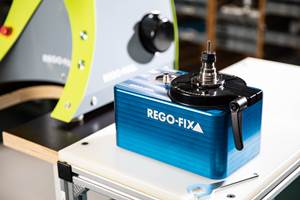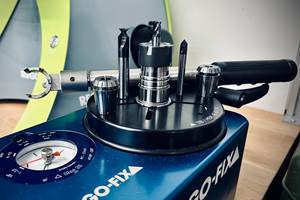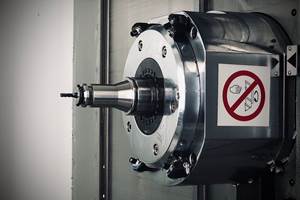Inspecting Tapers, Part 2: Toolholder Gaging
A few months ago, we discussed the calibration of conical taper masters, which are used to master taper gages. Now let's look at the parts those gages are used to inspect—toolholders.
Share





A few months ago, we discussed the calibration of conical taper masters, which are used to master taper gages. Now let's look at the parts those gages are used to inspect—toolholders.
There are many reasons for the popularity of V-flange toolholders. One advantage is that they are not self-locking but are secured in the spindle by the drawbar—an arrangement that makes tool changes simple and fast. They are also economical, because the taper itself is relatively easy to produce, requiring precision machining of only one dimension: the taper angle.
The toolholder must properly position the cutting tool relative to the spindle and, when in place, must rigidly maintain that relationship. The accuracy of the tapered surfaces on both the toolholder and the spindle is, therefore, critical.
If the toolholder's rate of taper is too great, there will be excessive clearance between the two surfaces at the small end of the taper. If the rate of taper is too small, there will be excessive clearance at the large end. Either situation can reduce the rigidity of the connection, and cause tool runout, which may show up on the workpiece as geometry and/or surface finish errors. Taper errors may also affect the amount of clearance between the flange on the tooling and the face of the spindle, which may create errors of axial positioning.
As the demands for precision machining and high speeds increase, manufacturing tolerances on spindle and toolholder tapers have gotten tighter. Nevertheless, both components are still subject to manufacturing inaccuracies and wear. In response, some companies with very high accuracy, quality, and throughput requirements—particularly in the aerospace and medical fields, and some automotive suppliers—regularly check the accuracy of toolholder tapers. This is usually done with differential air gaging, which combines the necessary high resolution and accuracy with the speed, ease of use, and ruggedness required on the shop floor.
The most common type of air gage taper tooling has two pairs of jets on opposing air circuits and is designed for a "jam fit" between the part and the tool. Jam-fit tooling does not measure part diameters, per se. Rather, it displays the diametrical difference at two points on the workpiece, as compared to the same two points on the master. If the difference at the large end of the taper is greater than the difference at the small end, as shown, the air pressure in circuit A will be lower than in circuit B: the gage will indicate this as negative taper. If the difference at B were greater than the difference at A, the gage would read positive taper. But because a differential air meter displays diametrical difference only, it will not display the part's diameter at either location. So while this type of air tooling provides a good indication of taper wear and allows us to predict a loss of rigidity in the connection, it does not tell us anything about the tool's axial positioning accuracy.
For that, we need a "clearance" style air tool. The tool cavity is sized to accept the entire toolholder taper, while the toolholder's flange is referenced against the top surface of the tool. This makes it possible to measure diameters at known heights (in addition to the change in clearance, as in the jam-fit type). An additional set of jets may be added, as shown, to inspect for bell-mouth and barrel-shap—two more conditions that reduce the contact area between the toolholder and the spindle.
Given a basic understanding of how your air gage works, both types of tooling are easy to use. Mastering is simply a matter of inserting the taper master and adjusting the zero. Measuring is even easier: Just insert the part and take the reading. Be careful when handling the heavy toolholders. Although the air tooling is very rugged, it's not totally impervious to damage.
Related Content
Five Common Mistakes Shops Make with ER Collets (And How to Prevent Them)
Collets play a crucial role in the machining process, so proper tool assembly and maintenance is important. Here are five potential pitfalls to avoid when using ER collets.
Read MoreMaking the Most of Mixed Toolholder Assemblies
While nearly all ER systems will have cross compatibility, they’ll have small differences across manufacturers that make their implementation at the shop level not as standard.
Read MorePlatinum Toolholding System Enables Quick Changeovers
The U-Tec changing system enables a standard ER output live tool to accept various adapters for different applications, enabling quick changeover of tools on almost any lathe or mill using a single tool.
Read MoreHow to Troubleshoot Issues With Tool Life
Diagnosing when a tool is failing is important because it sets an expectation and a benchmark for improvements. Finding out why gives us a clue for how to fix it.
Read MoreRead Next
AMRs Are Moving Into Manufacturing: 4 Considerations for Implementation
AMRs can provide a flexible, easy-to-use automation platform so long as manufacturers choose a suitable task and prepare their facilities.
Read MoreMachine Shop MBA
Making Chips and 91±¬ÁĎÍř are teaming up for a new podcast series called Machine Shop MBA—designed to help manufacturers measure their success against the industry’s best. Through the lens of the 91±¬ÁĎÍř benchmarking program, the series explores the KPIs that set high-performing shops apart, from machine utilization and first-pass yield to employee engagement and revenue per employee.
Read More



















